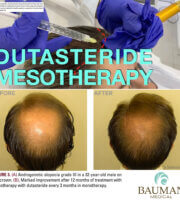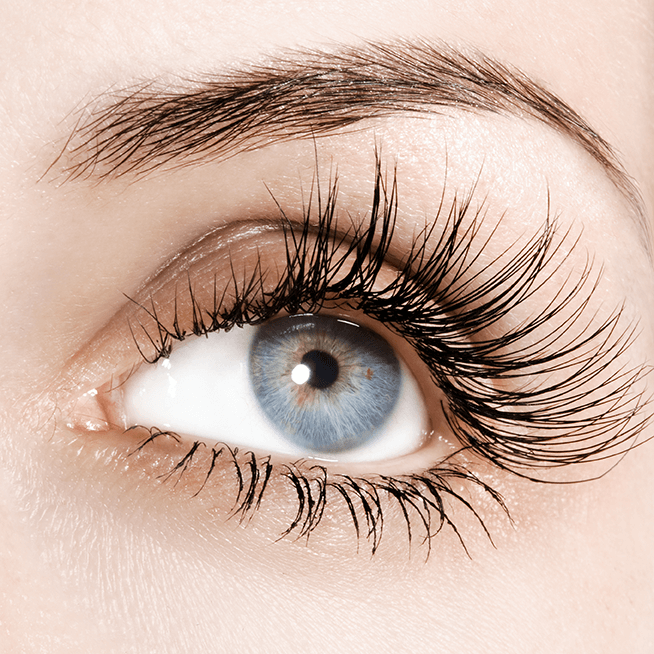Telogen Effluvium
by Alan J Bauman, MD
What is Telogen Effluvium?
Telogen Effluvium TE is a hair loss condition in which excessive amounts of hair fibers are shed from the scalp. “Telogen” refers to the resting phase of the hair follicle and “Effluvium” means literally a ‘flow’ or wave of discharge. It is generally seen in women aged 35-70 years, but it can also be observed in other ages and in men. Telogen Effluvium hair fall and hair shedding are common hair loss symptoms we treat at Bauman Medical.
What are the psychological effects of Telogen Effluvium?
Hair is an outward sign of youth and health, and hair loss is often associated with decreased Quality of Life. All types of alopecia or hair loss can result in increases in anxiety, depression, reduced self-confidence, loss of self-esteem, including feelings of stress, and changes in social behavior, like avoiding social gatherings. Physically “seeing” hair fall from the scalp can be an exquisitely troubling situation, especially for those who consider their hair to be a “defining factor.” Shedding can even trigger post-traumatic stress disorder as hair loss can be quite traumatizing for some.
How do I know if I have Telogen Effluvium?
While some hair shedding is expected every day from a healthy scalp, patients experiencing Telogen Effluvium report an “above average” daily or weekly hair fall. Some patients will track their daily hair fall by collecting hair in the shower, bed linens, and brushes. Sometimes, patients concerned about Telogen Effluvium will bring their hair collections into the clinic for evaluation. Telogen Effluvium can also be thought of as a synchronized shedding of hair. A detailed evaluation by a board-certified Hair Restoration Physician can help confirm the diagnosis of Telogen Effluvium, its severity and prognosis, the presence of other hair loss conditions, as well as develop an effective treatment plan and track your response to it over time.
Do I have Telogen Effluvium or Hair Breakage?
Both telogen effluvium and hair breakage can result in significant hair falling from your head during showering, drying, or styling. Hair breakage is usually due to overprocessing the hair fibers using color, curling, or straightening/relaxing treatments involving heat and chemicals, causing them to physically fray, snap, or break. The duration of exposure to the insults to the hair fiber (chemicals/heat) and the frequency of applying these treatments can make your hair fibers more prone to breakage. Hair at risk for breakage often loses its shine, looks dull, and feels rough to the touch.
Sometimes, a microscopic examination of the hair fibers is required to determine the difference between hair breakage (usually a short segment of frayed or split hair fiber) and shedding (an intact long hair fiber falling out from the root). The diagnosis can get complicated when hair cycles are shortening due to a hair loss process affecting the follicle, and shorter hairs are shed from the scalp.
What is normal hair shedding?
According to the medical literature, a healthy head of hair follicles will shed (and hopefully regrow!) approximately 100-200 hair fibers per day due to the natural cycling of hair follicles in and out of growing and resting phases over time. In telogen effluvium, hair fibers are shed during the hair cycle’s Exogen phase, which occurs between the Telogen phase and the follicle’s subsequent Anagen phase.
How does a normal hair follicle cycle through Anagen, Catagen, and Telogen/Exogen?
A normal healthy hair follicle will go through the phases of Anagen, or growth, during which time hair fiber is produced for five to seven years, then Catagen, which lasts for a few weeks during which time hair fiber production ceases and the follicle degenerates, then Telogen, the resting phase of the hair follicle which lasts about ninety days, finishing with the Exogen or shed of the hair fiber, before restarting back into anagen to repeat the cycle.
What is the difference between Acute Telogen Effluvium and Chronic Telogen Effluvium?
Acute telogen effluvium is a severe and sudden shedding phase that occurs once, whereas a “chronic” telogen effluvium is characterized by episodes of significant synchronized shedding that reoccur over time. Chronic telogen effluvium can occur annually, seasonally, or even monthly in some cases.
What causes Telogen Effluvium?
Because Telogen Effluvium is caused by a synchronized stoppage of hair production over a wide number of follicles, there can be many causes and triggers of TE. Some of the most common causes of hair follicles switching into telogen causing an effluvium are childbirth, surgery/general anesthesia, illness/infection (especially with high fever), vaccination (e.g., HPV or SARS-CoV-2), sudden severe physiological stress, crash diet, severe psychological stress, jetlag, sleep deprivation, changes in hormones, drugs/medications and hormone treatments including stopping/starting/changing birth control, COVID, Long-COVID.
When does Telogen Effluvium start after the triggering event and how long will it last?
Because of the growth cycles of the hair follicles, the Effluvium or shed associated with a triggering event (e.g., vaccine or COVID) is typically seen starting around two to three months after. Every case is different, but sometimes Acute Telogen Effluvium can last for six months. If telogen effluvium persists longer than six months, it may be considered “chronic.” Examples of acute telogen effluvium turning into chronic telogen effluvium is especially common in Long-COVID cases.
What else can cause a synchronized hair shedding phase?
One of the most overlooked yet common causes of significant shedding is the powerful effect of hair growth treatments containing minoxidil (e.g., 82M or 82F), starting low-level laser therapy hair growth treatments, and PRP platelet-rich plasma. Each of these hair growth treatments can shift resting hair follicles into the growing phase and trigger a large synchronized exodus or effluvium of hair within a month or two. Thankfully this is not a chronic shedding–it slows and stops within another few weeks. Hair measurements typically improve dramatically within 6-12 weeks of this kind of symptomatic response, and these measurements easily confirm the initial results of these hair growth treatments.
Can I have Telogen Effluvium along with another hair loss condition, like Androgenetic Alopecia?
Yes, especially in women 35-70 years old, there may also be an underlying genetic tendency toward female pattern hair loss or Androgenetic Alopecia, so it is crucial to have a board-certified hair restoration physician evaluate and measure your scalp in several different areas.
How is Telogen Effluvium diagnosed?
After a detailed history is obtained from the patient, including any risk factors for synchronized shedding previously mentioned and a description of the shedding condition, then a detailed physical evaluation and a variety of measurements of the hair and scalp are used performed and bloodwork may be requested. An evaluation may include a traditional “pull test” as well as dermoscopy/trichoscopy–a microscopic evaluation of the hair and scalp, HairCheck–a cross-sectional bundle measurement in various areas of the scalp, HairMetrix–an AI-powered microscope that measures hair density and individual hair caliber in multiple areas of the scalp, and a microscopic examination of any shed hair brought in by the patient. Sometimes, patients may be asked to perform a Wash Test or Modified Wash Test at home, a specific series of instructions to accurately collect hair fibers being shed from the scalp over a particular period of time.
How is Telogen Effluvium treated?
No one specific treatment regimen works best for all telogen effluvium patients. Typically, therapies such as minoxidil (topical or oral), laser therapy, Intact or similar treatment to treat the symptoms of shedding, regenerative treatments like PRP, nutritional supplementation, optimizing scalp health, addressing underlying hair loss risks, and routine tracking is critical for the success of any hair loss regimen.
*Each individual's treatment and/or results may vary
If you or someone you know has hair loss, hair thinning, baldness, or eyebrow / eyelash concerns, click to start either a long-distance virtual consultation OR an in-person, in-office consultation with Dr. Bauman. You can also Ask Dr. Bauman a Question or simply call Bauman Medical Group at +1-




 What is Dutasteride Mesotherapy?
What is Dutasteride Mesotherapy? Low Dose Oral Minoxidil For Hair Regrowth
Low Dose Oral Minoxidil For Hair Regrowth VIDEO: Biohackers Magazine Interview Podcast with Dr Alan Bauman Hair Loss Specialist
VIDEO: Biohackers Magazine Interview Podcast with Dr Alan Bauman Hair Loss Specialist VIDEO: What to do if you are just starting to lose your hair
VIDEO: What to do if you are just starting to lose your hair Dr. Alan J. Bauman, M.D.Hair Loss & Hair Transplant ExpertBoca Raton, FL
Dr. Alan J. Bauman, M.D.Hair Loss & Hair Transplant ExpertBoca Raton, FL






